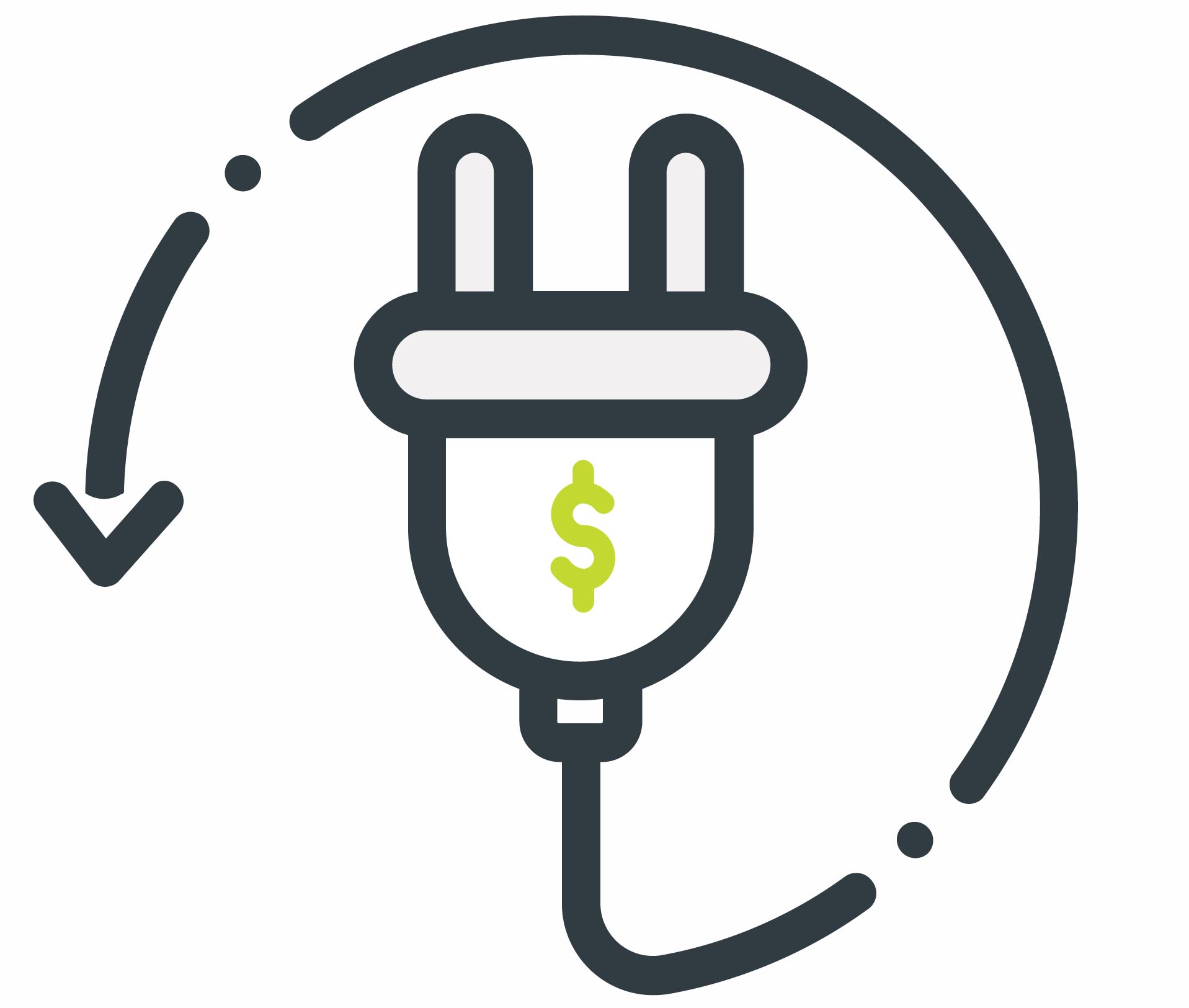High Efficiency LED Lighting for Your Office

When it comes to making the switch to high efficiency LED lighting at the office, advances in technology are creating massive improvements—both in terms of dollars and energy efficiency—for small businesses all the way up to large corporations. For those unfamiliar, high-efficiency lighting systems are those that consume less energy and last longer that traditional lighting systems. And for now, LEDs are the only real choice.
In the future, this will include smart lighting, which a lot of businesses are starting to adopt today. Smart lighting systems collect data, set rules, and maybe even be able to warm up your car for you (one day). These intelligent high efficiency lighting systems turn off lights if no movement is detected, dim the lights depending on the time of day, or even change colors! (Who doesn’t love mood lighting?) If you’ve been in the freezer aisle of grocery store lately, you might notice that some grocery store chains have coolers with lights that turn on and off when you approach it—that’s smart lighting in action.

Even if your annual budget doesn’t include a lighting system that thinks for itself, your company can prosper from more simple technological advancements. Simply switching from fluorescent, incandescent or halogen bulbs to LED lighting will have a big impact on your energy usage, and therefore, your bottom line.
Industries all across the world are investing in high efficiency lighting solutions. Even companies you wouldn’t think of, such as those that produce livestock, have a need for near constant lighting. Another biz you’ve likely heard of that has been using high efficiency lighting for years: Walmart. In 2014, Walmart began making a sizable shift by replacing outdated lighting systems with new, energy-efficient systems in 141 stores across four continents. The result was a 40 percent decrease in energy consumption over their traditional lighting as the main driver.
Want to go ahead and see if making the switch to high efficiency LED lighting could benefit your business? Click below to get started.
In this article, we’re going to explore the benefits of high-efficiency lighting in commercial buildings, options that are available to you, and how you can begin to make the shift for your office space.
The Benefits of LED Lighting in Offices
When it comes to using high efficiency lighting, even though you are helping the planet’s environment, you’re likely also going to help your own pocket too. In addition to reducing energy usage, you could save money over time with lower energy bills. And when you think about that in terms of the amount of energy that a business uses—the savings could be enormous! Let us explain a few of the major benefits of switching to LED office lighting solutions.
Energy Use
LED light bulbs require less energy to operate than traditional incandescent light bulbs do, which is a major factor in determining their lower environmental impact. Less energy consumption means less power plant emissions. It also means a reduction in dependency on non-renewable sources of energy and their corresponding environmental degradation.
What’s more, the electricity savings from using LED light bulbs are profound. According to Energy.gov, Energy Star LED bulbs “use at least 75 percent less energy, and last 25 times longer, than incandescent lighting.” Which doesn’t just have an impact on electricity consumption, but also on the physical waste produced from disposing of the bulbs themselves. Think about the waste implications of that 25 to1 ratio. By using LED bulbs, you produce substantially less waste. And with landfill space filling up at an alarming rate, waste reduction is an effort we can all support.
Cost-Effectiveness
LED high efficiency light bulbs are cost-effective for the same reasons. Less energy consumption means potentially less money spent on utility bills, so you could be saving long after you install them. Also, as previously explained, using LED light bulbs that last 25 times longer means replacing them much less often, and purchasing bulbs much less frequently. Not to mention, LED bulbs have come down in price in recent years, making them even more cost-effective than ever before.
Other Advantages
In addition to the environmental and financial benefits of using high-efficiency LED office lighting, there are a few other benefits of making the switch that don’t often get a lot of attention:
- LEDs contain no mercury vapor, unlike compact fluorescent bulbs
- They’re made of tougher materials and won’t break as easily
- They work well in extreme heat and cold
- They generate less heat, which lowers cooling costs
LED Use Around the World
According to Navigant Research, the expected global growth of high-efficiency lighting systems will skyrocket from $651.1 million in 2017 to $4.5 billion in 2026. And much of that growth is being driven by updated building codes. Not only will more businesses be adopting LED lighting, but residential buildings will too.

Numerous countries are phasing-out incandescent bulbs for more high-efficiency lighting systems, as well. This includes developing new regulations that ban the manufacture, import, and sale. Below is a list of countries that have started this process, and when they began this incandescent bulb phase-out process.
- Brazil and Venezuela – 2005
- EU, Switzerland, and Australia – 2009
- Argentina and Russia – 2012
- United States, Canada, Mexico, Malaysia, and South Korea – 2014
Types of LED Lighting Solutions
LED light bulbs come in every shape, size, and flavor – from the long tubes in your office ceiling, to standard-looking bulbs that power wall lights, desk task lights, lamps, and even oven and refrigerator lights.
LED Tube Lighting
There are a few options for replacing those long fluorescent tubes with LED tubes. From plug-and-play simple options, to replacing everything and making the whole office lighting system more LED-friendly, there’s likely an option that will best suit your company’s needs.
- Direct Fit – This is the simplest solution. This type of LED can plug directly into your preexisting older ballast. It’s easy, but it won’t be as efficient. Essentially, the bulb won’t last as long as it is designed to, and fit depends on your old ballast. You can take care of this yourself, without the help of a professional electrician.
- Internal Driver – "Driver" just means power supply, and internal driver means your bulbs are wired directly into the main power supply. They’re more efficient than direct fit bulbs and last longer, but they will require some electrical modifications, likely from a licensed electrician.
- External Driver – These LED bulbs will require a new ballast designed specifically for LED lights. This is the most expensive option, but it’s also the option that will yield the most benefits over the long run. Think: it’s by far the most efficient, and the best choice for functionality with dimming and future smart lighting options. This too will require some electrical experience or the help of a professional electrician. But it is well worth the investment, especially if you’re thinking about the potential of long-term future savings.
Variety of LED Bulbs
There are more styles of LED bulbs than there are unique snowflakes on a winter day. OK, that’s a bit of an exaggeration, but not by much! From the tiniest of oven lights to the heftiest flood lights, you’re sure to find the right size and shape you’re looking for personalized needs.
Besides the variety of shapes and sizes of LED bulbs, they also come in different brightness levels and color temperatures. Brightness levels of LED lights range from 220 lumens to 1300 lumens. And if you’re wondering about their dimmability, that depends on the bulb itself and the light fixture, as not every bulb and fixture is dimmable.
The color temperature distinctions of LED bulbs are soft white, bright white, and daylight. Soft white is considered the standard temperature. Bright white light is best-suited for offices and other work environments, while daylight bulbs are higher contrast and good for reading.
If you’re interested in purchasing LED bulbs, Home Depot has an excellent online inventory and a guide on how to choose the right bulb. And while some LED tube bulbs are not compatible with every ballast, that shouldn’t be a concern when purchasing the smaller, rounder bulbs.
Disposing of Different Types of Lightbulbs
Employees are left with two main options for disposing of old lightbulbs: either toss them out with your regular trash, or recycle them. (You also have a third: upcycling. If you’re an artist or creative type who wants to turn them into Christmas ornaments or beautiful works of art, that’s another option for you too). However, your options depend on what kind of bulb you’re getting rid of. Since LED bulbs do not contain any hazardous materials, they are the safest for the environment in terms of disposal.
- Incandescent – These bulbs contain standard materials, so you can throw them out with your trash. However, because of the glass shards, you may want to wrap them in something else for safety’s sake. If you are willing to drop them off to be recycled, check with Ikea or Home Depot, as both have a bulb-recycle program.
- CFL/Fluorescent – These contain mercury, so you can’t just toss them in with your trash. They’ll wind up damaging the environment and possibly getting into the water supply. Check with Lowe’s, other home improvement stores, and your local recycling centers.
- Halogen – It’s your choice. You have the option to toss them in the garbage. But if you want to recycle, check with your local recycling center to see if they’ll take them.
- LED Bulbs – These bulbs are also your choice how to discard of them. LED lightbulbs do not contain any hazardous materials (another plus for the environment), and some of their parts can be recycled. Again, check with your local recycling center for options near you.
Financing an Office-Wide High-Efficiency LED Lighting Upgrade
Upgrading to LED lights, in most cases, can be as simple as changing a lightbulb. However, when it comes to the tube lighting present in most offices, your best bet in the long-run will be to upgrade the entire lighting system.
If you’re thinking about upgrading your office’s lighting system to one that’s more environmentally and economically-friendly, consider Ygrene’s commercial home improvement financing options. Making the switch to high efficiency LED lighting at the office is a change that makes good sense. Well, actually, dollars and cents.

To get financing approval for a commercial lighting upgrade, go ahead and click below to get started (with no credit check).




